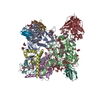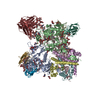+ Open data
Open data
- Basic information
Basic information
| Entry | Database: PDB / ID: 9auh | |||||||||
|---|---|---|---|---|---|---|---|---|---|---|
| Title | Cryo-EM structure of CH848.d949.10.17.GS-DH270.UCA3 | |||||||||
 Components Components |
| |||||||||
 Keywords Keywords | VIRAL PROTEIN/IMMUNE SYSTEM / Envelope / Glycoprotein / Trimer / Antibody / VIRAL PROTEIN / VIRAL PROTEIN-IMMUNE SYSTEM complex | |||||||||
| Function / homology |  Function and homology information Function and homology informationsymbiont-mediated perturbation of host defense response / positive regulation of plasma membrane raft polarization / positive regulation of receptor clustering / host cell endosome membrane / clathrin-dependent endocytosis of virus by host cell / viral protein processing / fusion of virus membrane with host plasma membrane / fusion of virus membrane with host endosome membrane / viral envelope / virion attachment to host cell ...symbiont-mediated perturbation of host defense response / positive regulation of plasma membrane raft polarization / positive regulation of receptor clustering / host cell endosome membrane / clathrin-dependent endocytosis of virus by host cell / viral protein processing / fusion of virus membrane with host plasma membrane / fusion of virus membrane with host endosome membrane / viral envelope / virion attachment to host cell / host cell plasma membrane / virion membrane / structural molecule activity / identical protein binding / membrane Similarity search - Function | |||||||||
| Biological species |   Human immunodeficiency virus 1 Human immunodeficiency virus 1 Homo sapiens (human) Homo sapiens (human) | |||||||||
| Method | ELECTRON MICROSCOPY / single particle reconstruction / cryo EM / Resolution: 3.6 Å | |||||||||
 Authors Authors | Zhang, Q.E. / Acharya, P. | |||||||||
| Funding support |  United States, 2items United States, 2items
| |||||||||
 Citation Citation |  Journal: Sci Transl Med / Year: 2025 Journal: Sci Transl Med / Year: 2025Title: An engineered immunogen activates diverse HIV broadly neutralizing antibody precursors and promotes acquisition of improbable mutations. Authors: Olivia M Swanson / Qianyi E Zhang / Elizabeth Van Itallie / Ming Tian / Alecia R Brown / Caitlin Harris / Anyway Brenda Kapingidza / Brianna Rhodes / Lena M Smith / Sravani Venkatayogi / ...Authors: Olivia M Swanson / Qianyi E Zhang / Elizabeth Van Itallie / Ming Tian / Alecia R Brown / Caitlin Harris / Anyway Brenda Kapingidza / Brianna Rhodes / Lena M Smith / Sravani Venkatayogi / Kenneth Cronin / McKenzie Frazier / Rob Parks / Maggie Bar / Chuancang Jiang / Joshua S Martin Beem / Hwei-Ling Cheng / Jillian Davis / Kelly McGovern / Amanda Newman / Robert J Edwards / Derek Cain / S Munir Alam / Kevin Wiehe / Kevin O Saunders / Priyamvada Acharya / Fred Alt / Barton F Haynes / Mihai L Azoitei /  Abstract: Elicitation of HIV broadly neutralizing antibodies (bnAbs) by vaccination first requires the activation of diverse precursors, followed by successive boosts that guide these responses to enhanced ...Elicitation of HIV broadly neutralizing antibodies (bnAbs) by vaccination first requires the activation of diverse precursors, followed by successive boosts that guide these responses to enhanced breadth through the acquisition of somatic mutations. Because HIV bnAbs contain mutations in their B cell receptors (BCRs) that are rarely generated during conventional B cell maturation, HIV vaccine immunogens must robustly engage and expand B cells with BCRs that contain these improbable mutations. Here, we engineered an immunogen that activates diverse precursors of an HIV V3-glycan bnAb and promotes their acquisition of a functionally critical improbable mutation. This immunogen was validated biochemically, structurally, and in three different humanized immunoglobulin mouse models that were designed to test HIV immunogens. These results provide a blueprint for rationally designing priming immunogens that explicitly target the elicitation of antibodies with functional yet improbable mutations. | |||||||||
| History |
|
- Structure visualization
Structure visualization
| Structure viewer | Molecule:  Molmil Molmil Jmol/JSmol Jmol/JSmol |
|---|
- Downloads & links
Downloads & links
- Download
Download
| PDBx/mmCIF format |  9auh.cif.gz 9auh.cif.gz | 464.7 KB | Display |  PDBx/mmCIF format PDBx/mmCIF format |
|---|---|---|---|---|
| PDB format |  pdb9auh.ent.gz pdb9auh.ent.gz | 381.3 KB | Display |  PDB format PDB format |
| PDBx/mmJSON format |  9auh.json.gz 9auh.json.gz | Tree view |  PDBx/mmJSON format PDBx/mmJSON format | |
| Others |  Other downloads Other downloads |
-Validation report
| Summary document |  9auh_validation.pdf.gz 9auh_validation.pdf.gz | 3.3 MB | Display |  wwPDB validaton report wwPDB validaton report |
|---|---|---|---|---|
| Full document |  9auh_full_validation.pdf.gz 9auh_full_validation.pdf.gz | 3.4 MB | Display | |
| Data in XML |  9auh_validation.xml.gz 9auh_validation.xml.gz | 83.3 KB | Display | |
| Data in CIF |  9auh_validation.cif.gz 9auh_validation.cif.gz | 123.5 KB | Display | |
| Arichive directory |  https://data.pdbj.org/pub/pdb/validation_reports/au/9auh https://data.pdbj.org/pub/pdb/validation_reports/au/9auh ftp://data.pdbj.org/pub/pdb/validation_reports/au/9auh ftp://data.pdbj.org/pub/pdb/validation_reports/au/9auh | HTTPS FTP |
-Related structure data
| Related structure data |  43880MC  9augC  9auiC M: map data used to model this data C: citing same article ( |
|---|---|
| Similar structure data | Similarity search - Function & homology  F&H Search F&H Search |
- Links
Links
- Assembly
Assembly
| Deposited unit | 
|
|---|---|
| 1 |
|
- Components
Components
-HIV-1 BG505 DS-SOSIP glycoprotein ... , 2 types, 6 molecules ABCDEF
| #1: Protein | Mass: 52505.453 Da / Num. of mol.: 3 / Fragment: d949.GS-gp120 Source method: isolated from a genetically manipulated source Details: d949.GS-gp120 / Source: (gene. exp.)   Human immunodeficiency virus 1 / Gene: env / Production host: Human immunodeficiency virus 1 / Gene: env / Production host:  Homo sapiens (human) / References: UniProt: Q2N0S6 Homo sapiens (human) / References: UniProt: Q2N0S6#2: Protein | Mass: 17146.482 Da / Num. of mol.: 3 / Fragment: UNP residues 509-661 Source method: isolated from a genetically manipulated source Details: d949.GS-gp41 / Source: (gene. exp.)   Human immunodeficiency virus 1 / Gene: env / Production host: Human immunodeficiency virus 1 / Gene: env / Production host:  Homo sapiens (human) / References: UniProt: Q2N0S6 Homo sapiens (human) / References: UniProt: Q2N0S6 |
|---|
-Antibody , 2 types, 6 molecules GHIJKL
| #3: Antibody | Mass: 24980.939 Da / Num. of mol.: 3 Source method: isolated from a genetically manipulated source Source: (gene. exp.)  Homo sapiens (human) / Production host: Homo sapiens (human) / Production host:  Homo sapiens (human) Homo sapiens (human)#4: Antibody | Mass: 22719.115 Da / Num. of mol.: 3 Source method: isolated from a genetically manipulated source Source: (gene. exp.)  Homo sapiens (human) / Production host: Homo sapiens (human) / Production host:  Homo sapiens (human) Homo sapiens (human) |
|---|
-Sugars , 6 types, 42 molecules 
| #5: Polysaccharide | Source method: isolated from a genetically manipulated source #6: Polysaccharide | alpha-D-mannopyranose-(1-2)-alpha-D-mannopyranose-(1-2)-alpha-D-mannopyranose-(1-3)-[alpha-D- ...alpha-D-mannopyranose-(1-2)-alpha-D-mannopyranose-(1-2)-alpha-D-mannopyranose-(1-3)-[alpha-D-mannopyranose-(1-3)-[alpha-D-mannopyranose-(1-6)]alpha-D-mannopyranose-(1-6)]beta-D-mannopyranose-(1-4)-2-acetamido-2-deoxy-beta-D-glucopyranose-(1-4)-2-acetamido-2-deoxy-beta-D-glucopyranose | Source method: isolated from a genetically manipulated source #7: Polysaccharide | Source method: isolated from a genetically manipulated source #8: Polysaccharide | Source method: isolated from a genetically manipulated source #9: Polysaccharide | Source method: isolated from a genetically manipulated source #10: Sugar | ChemComp-NAG / |
|---|
-Details
| Has ligand of interest | Y |
|---|---|
| Has protein modification | Y |
-Experimental details
-Experiment
| Experiment | Method: ELECTRON MICROSCOPY |
|---|---|
| EM experiment | Aggregation state: PARTICLE / 3D reconstruction method: single particle reconstruction |
- Sample preparation
Sample preparation
| Component | Name: Cryo-EM structure of CH848.d949.10.17.GS-DH270.UCA3 / Type: COMPLEX / Entity ID: #1-#4 / Source: RECOMBINANT |
|---|---|
| Source (natural) | Organism:   Human immunodeficiency virus 1 Human immunodeficiency virus 1 |
| Source (recombinant) | Organism:  Homo sapiens (human) Homo sapiens (human) |
| Buffer solution | pH: 8 |
| Specimen | Conc.: 1.2 mg/ml / Embedding applied: NO / Shadowing applied: NO / Staining applied: NO / Vitrification applied: YES |
| Specimen support | Grid material: COPPER / Grid mesh size: 300 divisions/in. / Grid type: Quantifoil R1.2/1.3 |
| Vitrification | Instrument: LEICA EM GP / Cryogen name: ETHANE / Humidity: 95 % / Chamber temperature: 295.15 K |
- Electron microscopy imaging
Electron microscopy imaging
| Experimental equipment |  Model: Titan Krios / Image courtesy: FEI Company |
|---|---|
| Microscopy | Model: FEI TITAN KRIOS |
| Electron gun | Electron source:  FIELD EMISSION GUN / Accelerating voltage: 300 kV / Illumination mode: FLOOD BEAM FIELD EMISSION GUN / Accelerating voltage: 300 kV / Illumination mode: FLOOD BEAM |
| Electron lens | Mode: BRIGHT FIELD / Nominal magnification: 81000 X / Nominal defocus max: 5000 nm / Nominal defocus min: 350 nm / Cs: 2.7 mm |
| Specimen holder | Cryogen: NITROGEN |
| Image recording | Electron dose: 66.3 e/Å2 / Film or detector model: GATAN K3 BIOQUANTUM (6k x 4k) / Num. of real images: 13821 |
| Image scans | Width: 5760 / Height: 4092 |
- Processing
Processing
| EM software |
| ||||||||||||||||
|---|---|---|---|---|---|---|---|---|---|---|---|---|---|---|---|---|---|
| CTF correction | Type: PHASE FLIPPING AND AMPLITUDE CORRECTION | ||||||||||||||||
| Particle selection | Num. of particles selected: 3920720 | ||||||||||||||||
| 3D reconstruction | Resolution: 3.6 Å / Resolution method: FSC 0.143 CUT-OFF / Num. of particles: 597407 / Symmetry type: POINT | ||||||||||||||||
| Atomic model building | Protocol: FLEXIBLE FIT / Space: REAL |
 Movie
Movie Controller
Controller





 PDBj
PDBj





